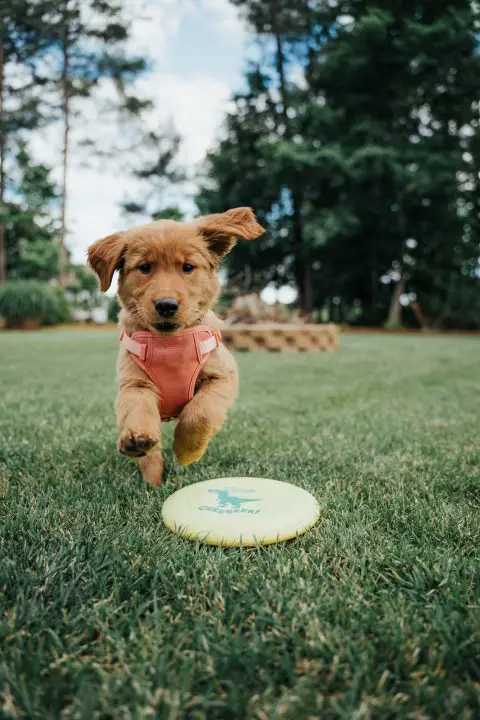Bringing home a new fur-child is always an exciting time. As a new pet parent, your first crucial role is to shape your puppy’s obedience and happiness. Puppy training is essential, especially since raising a fur baby can be just as exhausting as a human one. Regardless of when you bring your puppy home, you probably have questions about when to start working on crate training, potty training, and commands. Here is the general timeline for when to start training a puppy.

Table of Contents
- When to Start Training a Puppy Commands
- When to Start Crate Training a Puppy
- When to Start Potty Training a Puppy
- When to Start Leash Training a Puppy
- What to Expect By 6 Months
- What to Train Around 1 Year Old
- Is It Ever Too Late to Start Training a Puppy?
- Pawsitively Pawfect Timing
- FAQs
When to Start Training a Puppy Commands
Most puppies stay with their moms until they are about 8 weeks old. Some will stay even longer, depending on their circumstances. Even before 8 weeks old, the newborn pups are soaking in all kinds of information about the world. They can even learn bad behaviors very early on! So when you first get your pup, it’s important to have a training plan already in place; you don’t want to wait to get started with training.
As soon as you bring your puppy home, start working on their name and a few basic commands, such as “sit,” “stay,” “lay,” and “down.” Not only will this help your bond, but it also prevents behaviors like jumping on guests.
Be sure to use positive reinforcement, too. Give them treats whenever the pup does exactly as asked. Whenever a goal is achieved, show excitement and give them plenty of pets. This will cement the good behaviors in your puppy.
Just remember that puppies have short attention spans, just like human children (and adults), and shouldn’t be overwhelmed. Keep your training sessions short, about 5-10 minutes long. Do this a few times a week, building upon basic commands then advancing to more difficult ones.
Check out this timeline:
When to Start Crate Training a Puppy
Ideally, crate training happens around 8-10 weeks old. While many people feel that crate training has a negative impact, it can be beneficial when used correctly. In order to make crate training a breeze, never use the crate as punishment.
Here are some reasons why you should start crate training your puppy around 8-10 weeks:
- Having a crate makes your puppy like he is safe and at home. The crate should be somewhere your puppy wants to go when they are tired or stressed out.
- Crate training can reduce anxiety. Bringing a puppy into an unknown environment, away from her litter mates, can be extremely stressful. Plus, puppies get overstimulated. Rather than letting your little one run around anxious, give them a quiet place to unwind.
- Crate training helps with potty training. Puppies don’t like soiling where they sleep, which can help your pup learn how to control their bladder.
The video below outlines some excellent tips for crate training a puppy:
Crate training is important, especially if you don’t want bad sleep behaviors in the future, such as your dog sleeping on top of you.
When to Start Potty Training a Puppy
Housebreaking a puppy is one of the most important lessons you can teach them. But when should you start potty training a puppy? Usually around 12-16 weeks old. Before this period, puppies don’t have much control over their bladders, which is why puppy pads are crucial to keeping your floors clean! Yet, once they get to around 12 weeks old, you can start working on going outside.
Consistency is key with potty training a puppy. Set a time in the morning when you take out your pup every single day. Once your dog is aware that they will be outside soon, they can learn to control their bladders and hold it. Other times your puppy will need to pee includes in the morning, after food, after play, and after a long nap.
Whenever your put goes potty outside, give them a reward. Keep in mind that larger breeds of dogs can hold their pee much longer than smaller breeds. You will have to adjust the amount of time between potty breaks depending on the breed.
When to Start Leash Training a Puppy
Leash training can begin around the same time you bring your puppy home. That said, you shouldn’t put a harness and leash on your new fur baby and expect a wonderful time. Being leashed is a new experience, so you’re going to need patience.
Leash training is best partnered with potty training. However, most veterinarians recommend that puppies shouldn’t go outside among other dogs until they are fully vaccinated.
First, slip on the collar or harness for you puppy to get comfortable with it on. Next, let your pup trail around the leash for a while in a safe environment. Gently take hold of the leash and let them move around you. Take short walks. Let your puppy walk alongside you while they search for a place to potty.
As your pup gets older, focus on combining leash training with other obedience commands that your pup knows, such as “sit” and “stay.”
What to Expect By 6 Months
Now that you know when to start training a puppy, let’s talk about what you should expect as they get older. Hopefully, you brought your pup home at an early enough age that they have a great foundation. Now is when to start training a puppy to be polite!
Polite Play
Around 6 months, start ingraining in your puppy the meaning of “drop it” and “no biting.” This is when you set boundaries. What is your puppy allowed to do? What is prohibited? Make favorable behaviors clear with positive reinforcement.
Furthermore, if your puppy is teething still, you must give them plenty of toys. If they go after something else, take them away from whatever they were biting and give them a toy. Avoid negative reinforcement or the use of force as punishment.
Continued House Training
Potty training is usually a work in progress that can take up to several months, depending on the breed. Some breeds will master going to the bathroom outside relatively quickly. Others will need additional effort. However, your puppy should be making excellent progress regardless.
Recall
Around 6 months old is when to start training a puppy recall. This means that they hear the “come” command and they come. No questions asked. Don’t expect immediate recall in a younger puppy. Also, some breeds have no recall because of a strong prey drive, so keep a leash on your puppy while working the “come” command.
The most important thing is rewarding your dog whenever they do come back. You want them to love the thought of returning to your side.
What to Train Around 1 Year Old
Holy cow! Your puppy is already one year old. Doesn’t the time fly when you’re having an amazing time with a wiggly ball of joy? Around 1 year old, some puppies are still very much puppies, while others are already matured. That said, now is the time to focus on mastering a few skills.
Your puppy should understand sit, stay, down, and come. Even if there are distractions, your pup must be able to respond to these commands without any hesitation.
Leash, recall, and obedience are things that you never stop teaching your dog. Keep going strong with positive reinforcement!

Is It Ever Too Late to Start Training a Puppy?
Let’s say you found a puppy at the local shelter or rescue. While it is never too late to train a puppy or dog, you must keep in mind that some behaviors are now ingrained. Around 3-4 months old, early behaviors, including an emotional foundation (such as anxiety over confidence) will be permanent.
For example, if your rescue puppy learned early on that humans can’t be trusted, or that they needed to establish dominance in order to eat, you will have to work on aggression before anything else. Dogs that fear people have a harder time learning recall. Puppies that worry about their toys being taken by others won’t respond to the drop it command.
Patience is key with these kinds of puppies and dogs. Work on building trust and communication with your new companion. Show them that you can play gently, that you aren’t going to harm them. Once you can establish that, your puppy will be more eager to follow commands.
Remember: Positive reinforcement is something that all dogs love. You can quickly reverse poor behavior with just a little love and playfulness.
Pawsitively Pawfect Timing
If you wanted to know when to start training a puppy, the correct answer is as soon as you can. From 8-10 weeks, puppies need to start learning their name and some basic commands. Between 10-12 weeks, implement crate training. Around 12-16 weeks, begin housebreaking them. As your pup gets older, you can add in more kinds of training, including obedience and agility training, if desired.
Keep in mind that patience is key and it’s never too late to begin!
FAQs
Puppy training can begin as early as a few weeks old, but the specific age at which you start training your puppy depends on the type of training you’re focusing on and your puppy’s individual development.
The age at which a puppy might be considered the hardest to train can vary depending on the individual puppy, breed, and training methods used. Despite the potential challenges, early and ongoing training is essential to lay a foundation for a well-behaved and well-adjusted adult dog. If you’re finding certain stages particularly challenging, consider seeking guidance from a professional dog trainer or attending training classes to learn techniques that are effective for your puppy’s age and developmental stage.




